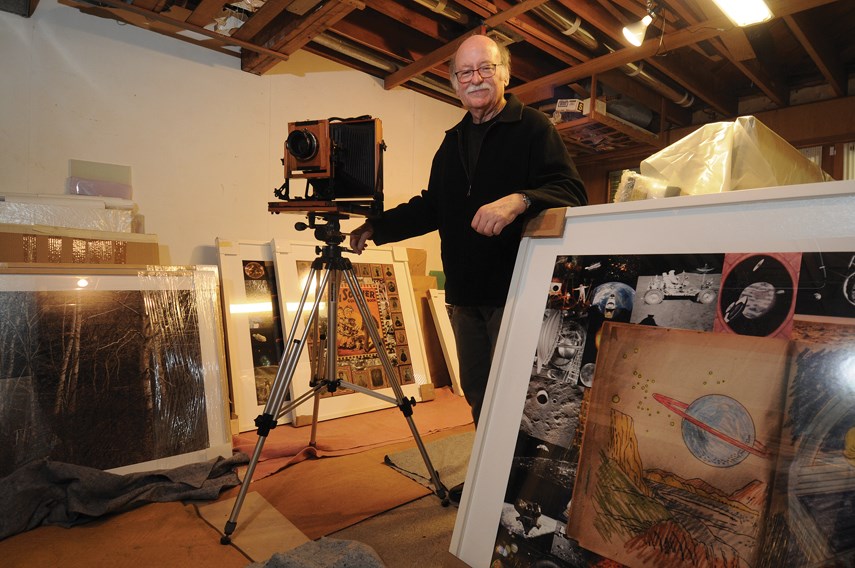West Vancouver based photographer Jim Breukelman is exploring a fresh creative direction. This one is musical.
“Music is aspirational for me,” he explains. “It started at fitness class, when a woman mentioned that she plays saxophone with the Second Chance Band. I remembered my cornet and thought I should try this. Maybe it was because I like the name of the band.”
Jim owns a cornet, purchased about 40 years ago from Ward Music in Vancouver. His connection with music goes back even further.
He was in the audience at the Newport Jazz Festival on a summer day in 1965 when folksinger Bob Dylan walked on stage with an electric guitar. It was an iconic moment in popular music history, but Jim’s formative musical memory from that time is jazz related.
It happened one evening at the Village Gate nightclub in New York City’s Greenwich Village, when Thelonious Monk, who liked to dance around the stage during a performance, stepped on Jim’s arm. “I considered not washing my jacket,” he recalls.
Jim learned to play trumpet during his school days, but he prefers the cornet for its sweet tone. Even so, work, family life and photography left no time for music beyond enjoying it. His cornet continued to rest comfortably in its case.
Jim’s cornet was made 53 years ago, in 1966. A year later, in 1967, Jim graduated from Rhode Island School of Design and embarked on a career that encompassed graphic design, teaching, and his own development as a photographer.
He packed up his Volkswagen Beetle with the tools of his trade – cameras, film, enlarger and developing trays – and set off from Rhode Island. Across the continent he drove to take up his first official commission: photographing the architecture of Simon Fraser University and of the Vancouver Aquarium. Commission completed and foraging for assignments, Jim visited the Vancouver School of Art. Jackpot! Or even, bonanza! He was offered the opportunity to start a department of fine art photography at the school.
Jim declined the school’s offer. He was a photographer, after all, and keen to practice his craft. Back in Rhode Island, Harry Callahan, who had established RISD’s photography department, assured his former student that he had the capacity to handle the job and told Jim to “call the school right now.”
The offer was still open. Back Jim drove again from East Coast to West Coast to take on the challenges of developing a new department and teaching students only a little younger than he was. “I was always only one or two steps ahead of my students,” he recalls.
The fine art photography department at the Vancouver School of Art was the first photography program in Canada to have a strong interdisciplinary focus. Until he retired in 2000, Jim’s teaching and administrative roles influenced the development of artists and photographic art in Vancouver.
In 1967, all that was in the future. The new department had a darkroom, but no equipment. All that was in the near future.
Meanwhile, Jim set up his enlarger and trays in the darkroom his father helped him make in his parents’ West Vancouver home. His mother made lunches for Jim and his students, all seven of them, when they returned from photographing the wilds of West Vancouver, a.k.a Lighthouse Park.
Jim’s students photographed nature and the city. He sent them to Chinatown and Strathcona and to the industrial areas, False Creek and Coal Harbour, built up over the past century, vanishing from the urban landscape, and from memory, during the 1960s and ’70s.
“The assignments had a documentary approach,” he says. “Real life is full of surprises, good and bad, and offers the potential of rich and vibrant images.”
Operating from that documentary foundation in his own work, Jim explores how, and why, we recreate, reconstitute and alter natural environments and the creatures that live in them, including ourselves.
Hot Properties, now in the collection of Canada’s National Gallery, portrayed houses on the verge of demolition in Vancouver’s real estate market circa 1987.
Two decades later, in 2013, long after those houses had been demolished, one image was resurrected. One homely little bungalow was selected for the first issue of a series of postage stamps celebrating the history of Canadian photography.
In Jim’s work, size matters. His photographs have been reduced to the size of a postage stamp, in the case of that bungalow from Hot Properties, and expanded enormously in Fish Ladder: Salmon in the Capilano. Five images – each five feet wide by eight feet high, with a total finished dimension of 41 feet wide and 10 feet high – were displayed at the downtown entrance to the Canada Line.
His recent work, on a slightly smaller scale, can be seen in Altered States, at West Vancouver Art Museum until May 11.
Size-wise musically, it’s a different story. The cornet is one of the smallest of the brass instruments. Jim is taking classes at the Vancouver Symphony Orchestra’s School of Music to sharpen his musical chops, and one day perhaps, he will play with the Second Chance Band.
Laura Anderson works with and for seniors on the North Shore. Contact her by phone at 778-279-2275 or email her at [email protected].



